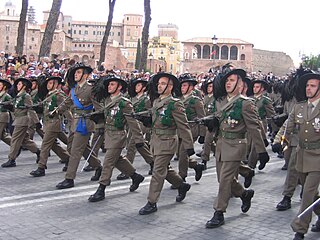
The Bersaglieri, singular Bersagliere, are a troop of marksmen in the Italian Army's infantry corps. They were originally created by General Alessandro Ferrero La Marmora on 18 June 1836 to serve in the Royal Sardinian Army, which later became the Royal Italian Army. They can be recognized by their distinctive wide-brimmed hats decorated with black western capercaillie feathers, which is worn with the dress uniform. The feathers are also applied to their combat helmets.
The article provides an overview of the entire chain of command and organization of the Italian Army after the reform of 1 May 2024 and includes all active units as of 1 May 2024. The Armed Forces of Italy are under the command of the Italian Supreme Defense Council, presided over by the President of the Italian Republic. The Italian Army is commanded by the Chief of the Army General Staff or "Capo di Stato Maggiore dell’Esercito" in Rome.

The Airmobile Brigade "Friuli" is an airmobile brigade of the Italian Army, based mainly in the Emilia-Romagna region. The brigade was part of the 1st Defence Forces Command until it was transferred to the Division "Friuli". The brigade's coat of arms depicts a stylized version of the Rocca di Monfalcone castle near the city of Monfalcone in the Friuli region, where the brigade distinguished itself during World War I. Since 1 July 2019 the brigade is part of the Division "Vittorio Veneto".

The Mechanized Brigade "Granatieri di Sardegna" is a mechanized infantry brigade of the Italian Army, based in Rome and central Italy. The brigade fields one of the oldest regiments of the Army and is one of the guard regiments of the President of Italy. The name of the unit dates back to the Kingdom of Sardinia and not the eponymous Mediterranean island of Sardinia. The brigade is part of the Division "Acqui".
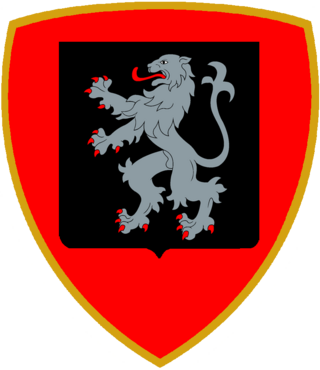
The Mechanized Brigade "Aosta" is a mechanized infantry brigade of the Italian Army based on the island of Sicily. The Brigade is one of the oldest of the Italian Army and the name connects the brigade to its original area of recruitment the Aosta Valley and therefore the brigade's coat of arms is modeled after the coat of arms of Aosta. The brigade is part of the Division "Acqui".

After World War II the Italian Army had two units named "Centauro": from 1952 to 1986 the Armored Division "Centauro" and from 1986 to 2002 the Armored Brigade "Centauro". Both units were successor to the World War II era 131st Armored Division "Centauro". The units' name came from the mythological race of half human-half horse creatures named Centaurs.

The Armored Brigade "Vittorio Veneto" was an armored brigade of the Italian Army. Its core units were armored and mechanized cavalry squadrons groups. The brigade's headquarters was in the city of Villa Opicina, with most of its units based in the Province of Trieste. The brigade's name was chosen to remember the decisive Italian World War I victory at the Battle of Vittorio Veneto.

The 132nd Armored Brigade "Ariete" is currently the only active armored brigade of the Italian Army. Its core units are tank and Bersaglieri regiments. The brigade's headquarters is in Pordenone, and most of its units are based in the North-East of Italy. The brigade's name comes from the battering ram. The brigade draws much of its historical traditions from the 132nd Armored Division "Ariete," which fought in the Western Desert Campaign of World War II. In 1948, the Ariete was reconstituted as a division and remained active until 1986. Today the brigade is part of the Division "Vittorio Veneto".
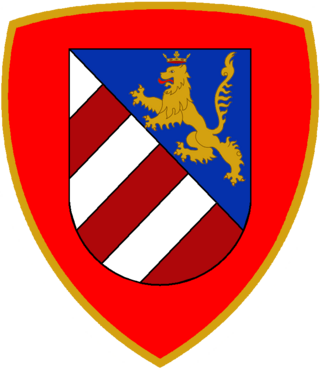
The Mechanized Brigade "Gorizia" was a mechanized brigade of the Italian Army. Its core units were mechanized infantry battalions. The brigade's headquarters was in the city of Gorizia and the brigade's units were based in the region of Friuli-Venezia Giulia. The brigade's name was chosen in memory of the World War I Battle of Gorizia. The brigade's sister brigade, the Armored Brigade "Vittorio Veneto", was named to commemorate the World War I Battle of Vittorio Veneto.

The 3rd Missile Brigade "Aquileia" was an artillery brigade of the Italian Army active between 1959 and 1991. The brigade was stationed in North-Eastern Italy and armed with missile and artillery systems capable of firing tactical nuclear weapons as part of Italy's participation in NATOs nuclear sharing programme. During peacetime the brigade fell under command of the Italian V Army Corps, but during wartime the brigade would have been subordinate to NATOs Allied Land Forces Southern Europe (LANDSOUTH) command in Verona. After the end of the Cold War the brigade was disbanded and its weapon systems retired.

The Mechanized Brigade "Legnano" was a mechanized brigade of the Italian Army. Its core units were mechanized infantry battalions. The brigade's headquarters was in the city of Bergamo in Lombardy. The name of the brigade commemorates the Lombard League victory in the Battle of Legnano in 1176 and its coat of arms depicts the Monument to the Warrior of Legnano in the centre of Legnano.

The Mechanized Brigade "Trieste" was a mechanized brigade of the Italian Army. Its core units were mechanized infantry battalions. The brigade's headquarter was in the city of Bologna. Named after the North-Eastern city of Trieste the brigade's coat of arms was modeled after the city's coat of arms.
The following is a hierarchical outline for the Italian Army at the end of the Cold War. It is intended to convey the connections and relationships between units and formations.
With the 1975 reforms the Italian Army abolished the regimental level and replaced it with brigades made up of multiple arms. During the reform the army disbanded 48 regimental commands and reduced its force by 87 battalions. A further ten regimental commands were used to raise ten new brigade commands. Ten training centers, which for traditional reasons had carried the names of regiments, were also disbanded. The reduction in units also allowed to mechanize most of the remaining units in Northern Italy and Italy's defense strategy changed from a hold-at-all-costs territorial defense to one of mobile warfare.

The 41st IMINT Regiment "Cordenons" is a Imagery Intelligence unit of the Italian Army. Originally a field artillery regiment, the regiment is today a multi-arms unit operationally assigned to the Tactical Intelligence Brigade, which combines elements of the artillery and signal arms. The regiment is based in Sora in Lazio.
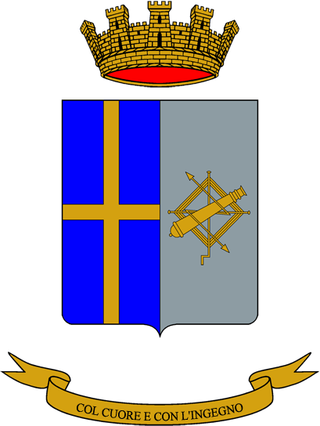
The 33rd EW Regiment is an Electronic Warfare unit of the Italian Army based in Treviso. Originally a unit of the army's signal arm, the regiment is today a multi-arms unit assigned to the Tactical Intelligence Brigade, which combines elements of the artillery and signal arms. The unit was formed in 1975 as a battalion and tasked with tactical electronic warfare operations in northeastern Italy. The battalion was named for Falzarego Pass and assigned to the V Territorial Military Command. In 1979, the battalion was transferred to the 5th Army Corps. In 1998, the 8th Signals Intelligence Battalion "Tonale" and 9th Electronic Warfare Battalion "Rombo" were disbanded and part of the two battalions tasks and personnel were transferred to the 33rd Electronic Warfare Battalion "Falzarego". In 2002, the battalion lost its autonomy and entered the newly formed 33rd EW Regiment. The regiment's anniversary falls, as for all signal units, on 20 June 1918, the day the Austro-Hungarian Army began its retreat across the Piave river during the Second Battle of the Piave River.

The 13th HUMINT Regiment is the Italian Army's only Human Intelligence unit. Formed on 1 August 1960 as Target Acquisition Battalion for the III Missile Brigade. In 1993 the battalion was disbanded. In 2005 the unit was reformed as a human intelligence battalion assigned to the army's RISTA-EW Brigade. Originally the unit was part of the army's artillery arm, but since becoming a human intelligence unit it has been designated as a "multi-arms unit". In 2018 the battalion was expanded to regiment and since then it is assigned to the Tactical Intelligence Brigade, which combines elements of the artillery and signal arms. The regiment is based in Anzio in Lazio. The regimental anniversary falls, as for all Italian Army artillery regiments, on June 15, the beginning of the Second Battle of the Piave River in 1918.
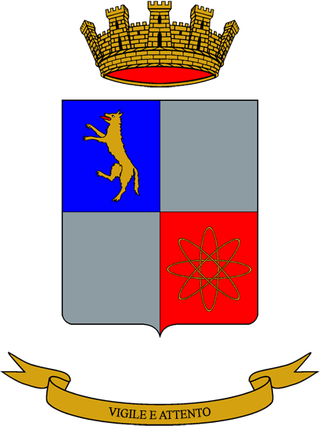
The 8th Signals Intelligence Battalion "Tonale" is a former signals intelligence (SIGINT) and currently signals battalion of the Italian Army. The battalion was formed in 1976 and named for the Tonale Pass. The battalion was the army's strategic signals intelligence unit during the Cold War. In 1998, he battalion was disbanded and its tasks and personnel transferred to the Italian Army's 33rd Electronic Warfare Battalion "Falzarego" and the Italian Armed Forces' Information and Security Department. In 2001, the battalion was reformed and assigned to the 11th Signal Regiment as the regiment's second signal battalion. The battalion's anniversary falls, as for all signal units, on 20 June 1918, the day the Austro-Hungarian Army began its retreat across the Piave river during the Second Battle of the Piave River.

The 7th CIMIC Regiment is a Civil-Military Co-operation regiment of the Italian Army based in Motta di Livenza in Veneto. The regiment is assigned to the Tactical Intelligence Brigade. In 1926, the Royal Italian Army formed the 7th Engineer Regiment in Florence. During the Second Italo-Ethiopian War and World War II the regiment's depot formed engineer battalions and smaller units, which deployed with divisions and corps to the fronts of the war. After the announcement of the Armistice of Cassibile on 8 September 1943 the regiment was disbanded by invading German forces. In 1944, the Italian Co-Belligerent Army formed the CIV Mixed Engineer Battalion for the Combat Group "Mantova", which fought on the allied side in the Italian campaign of World War II.

The 9th Cybernetic Security Regiment "Rombo" is a cyber warfare unit of the Italian Army based in Cecchignola in Rome. The regiment is part of the Signal Arm and assigned to the Tactical Intelligence Brigade. The regiment is tasked with performing cyber operations related to the defence of the Italian Army's IT networks and Command-and-Control systems, and with the protection of critical infrastructures, platforms and weapon systems.


















